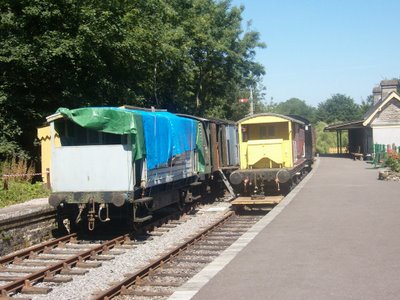
Whilst here at the S&D we are busy expanding our operations, the network outside has been doing the same. Over the last year the (non-heritage) sector has added 315 trains a day, and passenger numbers have increased by almost 3.6%. (source Railstaff, issue 104, July 2006). And this is before we see any real Peak Oil effects! It is also on a fairly static network, once lines are reopened on a regular basis then these figures will skyrocket. The real problem is going to be the ability to source trained staff, vehicles and materials (track etc).
It's impossible to over-emphasise the huge changes and expansion that will happen to the network in the coming decades. Almost all the Beeching cuts will be reversed, totally new lines will be built and there will be an enormous expansion in light and ultra-light rail.
I'm glad we just got our quarter mile plus of new track!


2 comments:
True, but they are beginning to see the light. Both the Bath and Bristol lines will have to eventually be restored, unless we're happy to live in a future without any transport more advanced than a horse and carriage. It won't be congestion that brings back the trains, but the impossibility of running a road network once oil runs out. The fixed costs of maintaining a road network may be acceptable now, but once the average person in the street can no longer afford to run a car (possibly less than 20 years ahead) investment will have to switch to rail unless we want the economy and possibly even civilization to disappear.
The important thing is that the S&D makes clear its ambitions now, not wait until everyone's saying what we are! The route to Bath is clear almost throughout, it will cost a lot to reinstate but it will be done gradually and without saddling us with huge interest costs because we won't borrow money to develop the route but probably do a number of share issues - which should pay a dividend. The Radstock-Bath route will be very successful in every way, tapping Bath's tourist potential, linking the large conurbation of Radstock-Norton to the network and allowing continued development in the post-car world. It will also bring in visitors to the line southwards from Midsomer Norton.
To be fair to the developers at Radstock they have polled the public who made it clear that there was little demand for a restored Radstock-Frome (or Westbury) route, what they wanted were trains to Bristol and Bath. We need to listen to our future passengers!
The houses on the Bath end of the Radstock section of the S&D should be bypassable, or it may be an option to purchase them as they become available. We really would rather not ever have to use the compulsory purchase route although if it did hold up plans for too long it would be wrong not to at least talk about using compulsory purchase.
The development at the old GW Radstock station (if it ever happens!) would not prejudice reinstatement of the Radstock-Bristol route as a new station could be built further towards Bristol near Radco, about where the S&D station is planned. I'm sure that careful grading and sympathetic development would allow a new Radstock station to serve both routes - to Bath and Bristol - in the future. A better site would be between the memorial gardens and the new housing development though, although this would require a level crossing on the Bath road.
I think personal transport in the future will be predominantly cycle or horse. Although electric power (which of course needs generating!), hydrogen (untried and dangerous energy-rich inputs) and biofuels (where would they actually grow the crops and would it even be an energy generator considering the huge inputs required?) are offered by a scared government as alternatives, economically none are viable and all would add greatly to climate change.
I think history will look back on the oil age as a short-lived aberration and the sooner we are over it the quicker we can get back to creating a proper sustainable, solar and human-sized economy and society!
Post a Comment